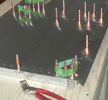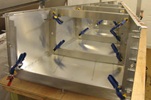


random user submitted photo
Treatment needed after scotch-brite?
8 posts
• Page 1 of 1
Treatment needed after scotch-brite?
Is it necessary to treat a skin area after using maroon scotch-brite to polish up after deburring prior to riveting? I used scotch-brite to smooth / polish the inside skin rivet lines prior to joining.


Ken S
SONEX #1243 N424SX (reserved)
Tail complete, wings done
Fuselage on gear
Jab 3300 received!
SONEX #1243 N424SX (reserved)
Tail complete, wings done
Fuselage on gear
Jab 3300 received!
- Sonex1243
- Posts: 312
- Joined: Thu Jan 08, 2015 4:59 pm
Re: Treatment needed after scotch-brite?
Nope!
Bryan Cotton
Poplar Grove, IL C77
Waiex 191 N191YX
Taildragger, Aerovee, acro ailerons
dual sticks with sport trainer controls
Prebuilt spars and machined angle kit
Year 2 flying and approaching 200 hours December 23
Poplar Grove, IL C77
Waiex 191 N191YX
Taildragger, Aerovee, acro ailerons
dual sticks with sport trainer controls
Prebuilt spars and machined angle kit
Year 2 flying and approaching 200 hours December 23
-

Bryan Cotton - Posts: 5489
- Joined: Mon Jul 01, 2013 9:54 pm
- Location: C77
Re: Treatment needed after scotch-brite?
Funny how a guy starts to second guess himself...
Thanks for the insight Bryan.
Thanks for the insight Bryan.
Ken S
SONEX #1243 N424SX (reserved)
Tail complete, wings done
Fuselage on gear
Jab 3300 received!
SONEX #1243 N424SX (reserved)
Tail complete, wings done
Fuselage on gear
Jab 3300 received!
- Sonex1243
- Posts: 312
- Joined: Thu Jan 08, 2015 4:59 pm
Re: Treatment needed after scotch-brite?
Ken -
While its not 100% necessary to do anything after scotch-briting, here are a couple of things to think about:
Personally, I wanted to use rattle-can primer on the inside of my major parts. So I developed the following sequence of steps for cleaning all critical parts after deburring them and smoothing all edges:
Now, is it necessary to do all of the items above, in order to have a flyable airplane? Nope! But it ensures a clean, sturdy airframe. And if you do these cleanings in batches (i.e. build and cleco a whole fuselage side, then take it all apart and perform these steps on all of the items at once) then it doesn't add that much time to the build.
Enjoy,
--Noel
Sonex #1339
Photo Album of my build [newest items on top]: https://flic.kr/s/aHskrtEG22
While its not 100% necessary to do anything after scotch-briting, here are a couple of things to think about:
- If you don't at least wipe down the surface, you're going to have small bits of scotch-brite pad & grit on the part - so when you join two pieces together that stuff will be trapped in between them. These particulates could accelerate corrosion (i.e. dissimilar metals promote a mild galvanic reaction over time, and the particulates can help create small spaces for moisture to be retained between parts). In areas with lots of vibration or deflection under load, these particulates could also continue to perform their duty as an abrasive on these parts.
- There are probably skin-oils and other residues on the part, which will serve to help the particulates stick to the surface (and will also inhibit anything from adhering to the surface, like paint or adhesives or sealants). So you might want to wipe down the surface with a rag or shop-towel that has some zero-residue cleaner or thinner or mineral spirits on it.
- Sometimes the amount of dust/particulates requires several passes with a thinner-soaked towel; which can be messy and wasteful. A quick wash with a bit of water and a mild liquid soap - like Dawn - quickly and easily breaks up the oil and grit and allows it to float off the surface when sprayed gently with a garden hose.
Personally, I wanted to use rattle-can primer on the inside of my major parts. So I developed the following sequence of steps for cleaning all critical parts after deburring them and smoothing all edges:
- Wipe the part with thinner or another mild solvent to remove tape residue, marker, oils, or other contamination.
- Use a maroon scotchbrite pad to achieve a satin finish on the parts where they face the interior and/or are a mating surface.
- Take parts outside and put them on sawhorses or stand them on-edge.
- Use garden hose with sprayer attachment to mist the parts with water.
- Use a small amount of Dawn liquid dishwashing soap on the part, and "massage" it all over the part. I find that wearing a latex glove makes it easy to get quick & even coverage by wiping/swirling my hand across the part with an open palm & outstretched fingers, using mild to moderate pressure). NOTE: The glove helps you avoid minor nicks and cuts, but make sure you have deburred your holes before doing this, to avoid injury!
- Use the hose to spray/rinse the part off, until you don't see any more soapy residue anywhere on the part.
- Air-dry or towel-dry the part.
- Bring the part back into the workshop and give it one more quick wipe-down with a zero-residue cleaner (thinner/mineral-spirits/etc).
- Spray primer on the part, if desired.
Now, is it necessary to do all of the items above, in order to have a flyable airplane? Nope! But it ensures a clean, sturdy airframe. And if you do these cleanings in batches (i.e. build and cleco a whole fuselage side, then take it all apart and perform these steps on all of the items at once) then it doesn't add that much time to the build.
Enjoy,
--Noel
Sonex #1339
Photo Album of my build [newest items on top]: https://flic.kr/s/aHskrtEG22
- NWade
- Posts: 527
- Joined: Mon Aug 08, 2011 3:58 pm
Re: Treatment needed after scotch-brite?
Hi all,
We found that after scotch brite , wiping with acetone worked well. Then primered w duplicolor self etching primer from kragen auto supply. Sticks well and runs flow out well. Medium green.
WaiexN143NM
Michael
We found that after scotch brite , wiping with acetone worked well. Then primered w duplicolor self etching primer from kragen auto supply. Sticks well and runs flow out well. Medium green.
WaiexN143NM
Michael
- WaiexN143NM
- Posts: 1206
- Joined: Mon Sep 15, 2014 1:04 am
- Location: palm springs CA
Re: Treatment needed after scotch-brite?
I always wiped all my joining surfaces down with acetone after doing the exact scotch-brite method on rivet lines as described. Acetone in a spray bottle was always my go-to cleanup solvent when finalizing parts, since it was also the best way I'd found to remove sharpie marks and part labels.
Ryan Roth
N197RR - Waiex #197 (Turbo Aerovee Taildragger)
Knoxville, TN (Hangar at KRKW)
My project blog: http://www.rynoth.com/wordpress/waiex/
Time-lapse video of my build: https://www.youtube.com/watch?v=Q8QTd2HoyAM
N197RR - Waiex #197 (Turbo Aerovee Taildragger)
Knoxville, TN (Hangar at KRKW)
My project blog: http://www.rynoth.com/wordpress/waiex/
Time-lapse video of my build: https://www.youtube.com/watch?v=Q8QTd2HoyAM
-

Rynoth - Posts: 1308
- Joined: Fri Jul 26, 2013 1:32 pm
- Location: Knoxville, TN
Re: Treatment needed after scotch-brite?
More great idea's, thanks everyone. On a side note, I failed to mention in the original post that I have been wiping everything down with mineral spirits. I may switch to acetone as the spirits don't seem to remove the marker marks very well.
Ken S
SONEX #1243 N424SX (reserved)
Tail complete, wings done
Fuselage on gear
Jab 3300 received!
SONEX #1243 N424SX (reserved)
Tail complete, wings done
Fuselage on gear
Jab 3300 received!
- Sonex1243
- Posts: 312
- Joined: Thu Jan 08, 2015 4:59 pm
Re: Treatment needed after scotch-brite?
I used 95% alcohol to remove labels and magic marker lines. Less toxic than acetone.
Darick Gundy
Sonex #1646
N417DG
Taildragger, Aerovee, center stick, Prince P-Tip Prop
MGL E1, F2, V6 radio, Sandia Xponder, Reserve lift indicator (AOA), iFly 520
First flight! 10/21/2017
Sonex #1646
N417DG
Taildragger, Aerovee, center stick, Prince P-Tip Prop
MGL E1, F2, V6 radio, Sandia Xponder, Reserve lift indicator (AOA), iFly 520
First flight! 10/21/2017
-

Darick - Posts: 496
- Joined: Mon Aug 05, 2013 9:39 pm
- Location: PA
8 posts
• Page 1 of 1
Who is online
Users browsing this forum: No registered users and 8 guests







